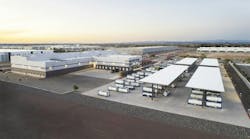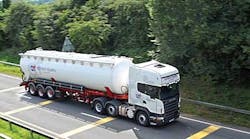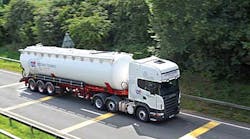EFFICIENT logistics and transportation play critical roles in the food distribution process. Providers are constantly working to tweak the processes to ensure that customers receive the best possible services.
A good case in point is British trucking and logistics provider Atchison Topeka, which consolidated multiple food distribution centers into a single facility in Droitwich, Worcestershire that transfers powdered food ingredients from bulk bags into dry bulk trailers.
Atchison Topeka serves the distribution facility with a fleet of 68-cubic-meter (2,401-cu-ft) pressure-tank-style dry bulk trailers. More than 100,000 metric tonnes (220.4 million pounds) of product is distributed in bulk from the facility every year. Powdered foods include whey and buttermilk.
The truck fleet — along with the specialized handling and loading system at the Droitwich distribution center — gives Atchison Topeka the ability to deliver bulk powdered foods across the United Kingdom and Europe.
The plant's powder handling system can handle a wide range of powdered foods, and it is modular, which means the system can be quickly and easily reconfigured to meet specific customer needs. The system delivers an unprecedented level of efficiency, cleanliness, and reduced labor requirements, according to Atchison Topeka officials.
Closed-loop system
The closed-loop transfer system consists of a bulk bag discharger integrated with pneumatic conveying equipment that blows bulk material into the dry bulk trailers, while recirculating displaced air and recovering dust from the airstream.
To meet food industry standards, the process was required to comply with BRC (British Retail Consortium) requirements in three areas: bulk tankers, warehousing, and palletized distribution. While the facility would be handling a variety of food ingredients, analysis showed that most exhibited bulk densities of approximately 40 lb/cu ft (650 kg/cu m). Most were also free-flowing or semi-free flowing, with an angle of repose of 40 degrees to 60 degrees. One of the ingredients, however, was relatively hygroscopic and prone to bridging, so the equipment needed to prevent cavitation.
At the heart of the bulk transfer system is a Model BFC bulk bag discharger configured with a cantilevered I-beam, electric hoist and trolley, flow promotion devices, and a hopper equipped with a rotary airlock valve. The bulk bag discharger and other key components in the system were supplied by Flexicon Corporation, a worldwide manufacturer of bulk handling equipment and custom-engineered and integrated plant-wide systems that transport, discharge, fill, weigh, blend, deliver, and/or feed a broad range of powder and bulk solid materials.
The dilute phase pneumatic conveying portion of the system consists of a positive displacement pressure blower, pneumatic conveying line and a filter receiver located downstream from the bulk tanker truck. Automated controls orchestrate operation of the flow promotion devices, rotary airlock valves, blower, and filter receiver. All material contact surfaces throughout the system are of 304 stainless steel finished to food standards.
To start the process, a forklift or pallet jack is used to place a bulk bag (up to one metric tonne-2,204 pounds) in front of the discharge frame, where an operator attaches four bag loops to clips on the unit's bag lifting frame and, using a pendant, activates the hoist to raise the bag, and the trolley to move it into the frame, and after which it is lowered onto the spout connection point.
A Flexicon Spout-Lock clamp ring, which is mounted atop a Tele-Tube telescoping tube, securely connects the clean side of the bag spout to the clean side of the equipment, after which the telescoping tube exerts continuous downward tension on the bag spout. The operator then releases the bag spout's drawstring, allowing material to fall freely into the hopper with no dusting.
Flexicon Flow Flexer plates raise opposite bottom edges of the bag into a steep “V” shape, loosening compacted material, while constant downward tension exerted by the telescoping tube as the bag empties/elongates promotes complete discharge from the bag.
Pneumatic transfer
Material in the hopper is fed through a rotary airlock valve and pneumatic pick-up adapter into a pneumatic line that runs horizontally for 39 inches and at an incline before penetrating the exterior wall of the building to discharge material into a tanker trailer.
The air stream provides sufficient force to blow the material the full length of the trailer's interior. A return line vents displaced air and dust to the filter receiver that collects any carry-over material for later reintroduction to the pneumatic conveying system.
The modular components in Flexicon's bag-to-truck transfer system make it possible for the Atchison Topeka distribution center to repurpose the hardware for other applications, such as new materials with varied handling characteristics or transferring powders from dry bulk trailers to bulk bags.
Besides improving efficiency and flexibility, the dust-tight bulk bag discharger with totally enclosed pneumatic conveying prevents contamination of the product and plant environment, eliminates
the need for a clean room, and simplifies quality control
procedures. ♦















